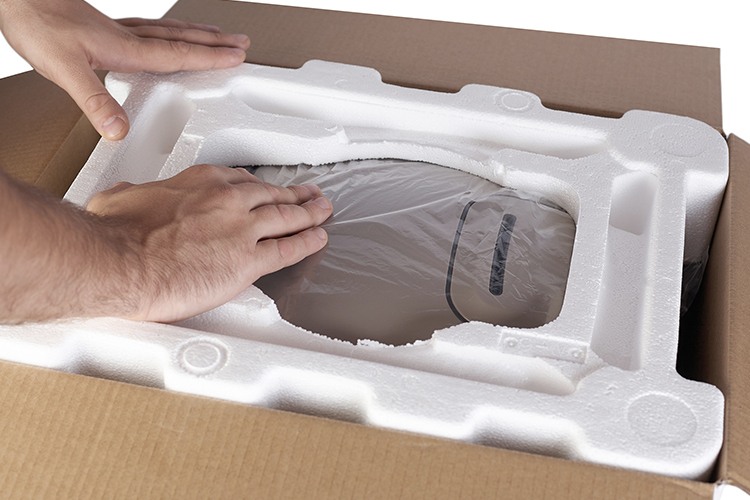Styrofoam is a popular material that’s used for home insulation and craft supplies. Despite popular belief, however, it is not the material used to make disposable cups, coolers, packing peanuts and carry-out containers. Styrofoam is a registered trademark for a particular type of closed-cell, extruded polystyrene foam. Those other products may look like Styrofoam, but they are a different material known as expanded polystyrene foam. They are also not covered under the trademark for Styrofoam, which is held by the DuPont company.

How It Started
The invention of Styrofoam is a long story that begins with the discovery of polystyrene. In 1839, a German pharmacist named Eduard Simon isolated a rubbery substance from resin. He had discovered polystyrene, but he didn’t know of any proper uses for this new substance.
Another German chemist, Hermann Staudinger, later figured out that the substance was a plastic polymer. Staudinger’s studies found that processing under heat could create a synthetic version of rubber. Staudinger won a Nobel Prize in 1953 for his advances in polymer research.
German companies began manufacturing polystyrene for commercial use in the early 20th century. In 1937, Dow Chemical realized this substance could have many possibilities in the U.S. In 1937, Dow introduced its own form of polystyrene to the U.S. market.
Ray McIntire Invents Styrofoam
The next step happened in 1944. Ray McIntire, a Dow Chemical engineer, was trying to create a flexible insulator for electrical wiring. Rubber was expensive to produce on a mass scale, and pure polystyrene was too brittle to be a suitable alternative.
McIntire combined polystyrene with isobutylene and put them both under pressure. The result was a foam polystyrene substance with a bubbled appearance. It was lightweight, flexible and tough. It also worked extremely well as an insulator.
Insulation and Crafts
McIntire named his discovery Styrofoam, and it quickly became one of Dow Chemical’s most popular products. Inexpensive to make and able to withstand temperature extremes, it had many uses. Dow developed it into a form of building insulation.
Still widely used today, this insulation is also known as blueboard because of its pale blue color. Its trademarked name is Styrofoam™ Brand XPS Insulation. Styrofoam is also used to make the green or white blocks that decorators use in floral arrangements.
These are the only products made from original Styrofoam.
Other Products
What about all those cups, plates and other materials? They may look and feel like Styrofoam, but they are simply polystyrene.
According to the DuPont website, “There isn’t a cup, food container, cooler or packaging material in the world made from Styrofoam™ brand material. Those items are made from a type of expanded polystyrene (EPS) that doesn’t have the insulation value, moisture resistance or compression strength of Styrofoam™ brand.”
Avoiding Genericide
DuPont holds the trademarks on several well-known brand names, including Tyvek and Kevlar. Like Styrofoam, these are popular names that sometimes get used as generic terms. DuPont’s insistence on the correct use and spelling of its products is one way it can avoid genericide.
Genericide is a legal term for a brand name that loses its trademark status. This can happen if a trademark owner fails to protect its trademark. It can also happen if a petitioner can make a convincing court case that the term should be considered generic. (We covered this and other ways you can lose a trademark.)
Trademark Protection Is Key
Both these things have happened to many well-known brands. Some names that were once trademarked include kerosene, lanolin, flip phone, laundromat and videotape.
On this blog, we have looked at the efforts of companies that own well-known brands like Popsicle, Band-Aid and TASER to protect their trademarks. In some cases, regular reminders have been enough to remind the public that these terms are not generic. Others have required aggressive litigation to protect themselves from trademark dilution and genericide.
Their efforts show that simply getting a trademark isn’t enough. You must be prepared to fight for it. Many companies routinely monitor news reports, social media and retail operations to ensure their trademark is being used correctly.
Read more on common word and phrase trademarks.
After Styrofoam
After inventing Styrofoam, McIntire continued to work at Dow Chemical, where he spent his entire career. He did not make any profit from his invention aside from his Dow salary. He retired from the company in 1981 as its director of technology and acquisitions.
In 2017, DuPont and Dow Chemical merged. In 2019, they split into three separate companies: Dow, DuPont and Corteva. DuPont took over the Styrofoam trademark in 2019. It currently holds over 150 trademark registrations worldwide for the Styrofoam™ brand.
Concerns and Controversies
Despite its popularity, Styrofoam has been surrounded by controversy. Initially, producing it required large amounts of chlorofluorocarbons (CFC), which depleted the ozone layer. Today, production uses alternatives to CFC, but there are still concerns. The foam’s base material, styrene monomer, is strongly linked to the development of cancer.
Most of the concerns about Styrofoam are about its environmental impact. Styrofoam takes hundreds of years to degrade, and the similar non-Styrofoam products take just as long. More than half of all expanded foam products end up in landfills or in ocean waters. It is also difficult to recycle. In response to these concerns, many cities and municipalities have instituted bans on single-use plastics and foam containers.
Dow and DuPont have both been plaintiffs in large litigation trials over pollution and toxic leaks. At this time, however, none of those lawsuits have involved Styrofoam.
Styrofoam Is Standing Strong
Although there have been no strong legal challenges to the Styrofoam trademark, DuPont has been willing to litigate when protecting its other registered trademarks. It is likely to respond quickly to any attempts to make Styrofoam a generic term.

